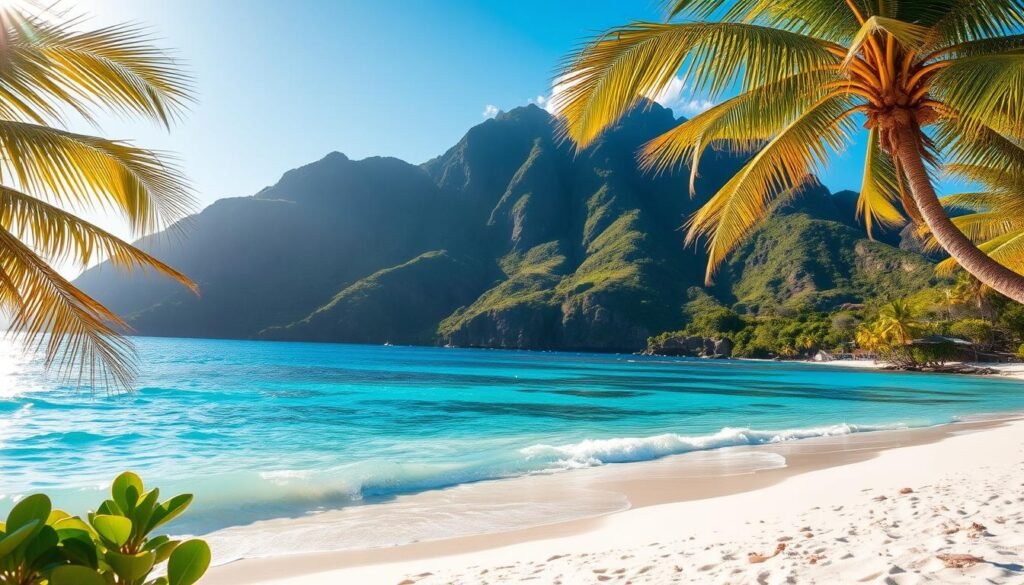Surprising fact: more than half of annual bookings land between mid-December and mid-April, making those months the busiest on the island.
I write this guide in first person to help you pick when to go. I answer what matters most: sunshine, sea clarity, hotel availability, and the overall atmosphere.
The high season runs from mid-December to mid-April and brings the sunniest skies and calm seas. That stretch draws lots of visitors and fills hotels fast, so I recommend planning early.
The shoulder months, mid-April through June, often offer a great balance. You can enjoy good weather, easier airfare, and fewer crowds.
Low season from June through November lowers prices and gives the island a relaxed, greener feel. If you want quiet beaches and softer rates, this period can be ideal.
Key Takeaways
- Peak months (mid-Dec–mid-Apr) deliver the most sunshine and calm seas.
- Shoulder season (mid-Apr–Jun) balances weather and lower crowds.
- Low season (Jun–Nov) means lower hotel rates and a quieter vibe.
- Coolest months are Jan–Feb; warmest run May–Sep.
- Book 6–12 months ahead for peak travel windows to secure oceanfront rooms.
How I decide the best time to visit Saint Lucia right now
My method is simple: match what matters most to you with the island’s seasonal rhythms. I focus on four priorities — weather, crowds, price, and events — so your plan fits your style, not a generic checklist.
User priorities: weather, crowds, price, and events
I weigh each factor against the trip length and daily plans. If you want calm seas and solid sun for beach days, the dry season is the clear pick.
If lower rates and room availability matter, the shoulder months (mid-April–June) often give similar weather with fewer people and better deals.
Quick answer at a glance: dry season vs. shoulder months
“For reliably sunny days, choose the dry window; for value and space on the sand, pick shoulder months.”
Peak demand runs mid-December through mid-April, which pushes flights and hotel rates up. Book several months ahead if your dates fall in that peak.
- Dry season (peak): Sunny, calm seas, high demand.
- Shoulder: Similar weather, fewer crowds, easier booking.
- Off-season: More value, greener island, occasional showers.
Saint Lucia seasons explained: dry season and wet season
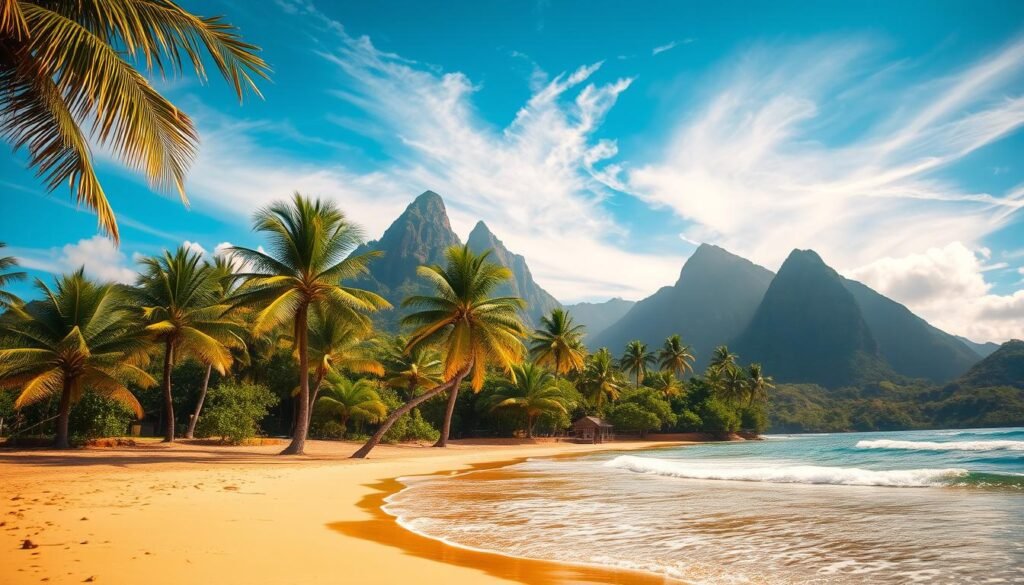
I break Saint Lucia’s year into clear season blocks so you can match weather and mood.
Dry season (December–April) is the sunniest stretch. Expect calm seas, steady sunshine, and a lively atmosphere. Cooler breezes arrive in December through February, making outdoor plans comfortable. This stretch is ideal for classic beach days and easy snorkeling.
Wet season runs June–November and brings greener landscapes and brief, often fast-moving showers. Rainfall comes in bursts, then the sky clears. Temperatures and humidity rise, which rewards hikes and waterfalls with lush views.
Shoulder sweet spots
Mid-April–June and October–November balance good weather and fewer crowds. You’ll get plenty of sunshine with lower rates and workable humidity.
- December–April: predictable calm seas and sun.
- June–November: quieter beaches, greener island scenes.
- Shoulder months: best mix of availability and favorable weather.
Weather by the numbers: temperatures, rain, humidity, sunshine, and sea
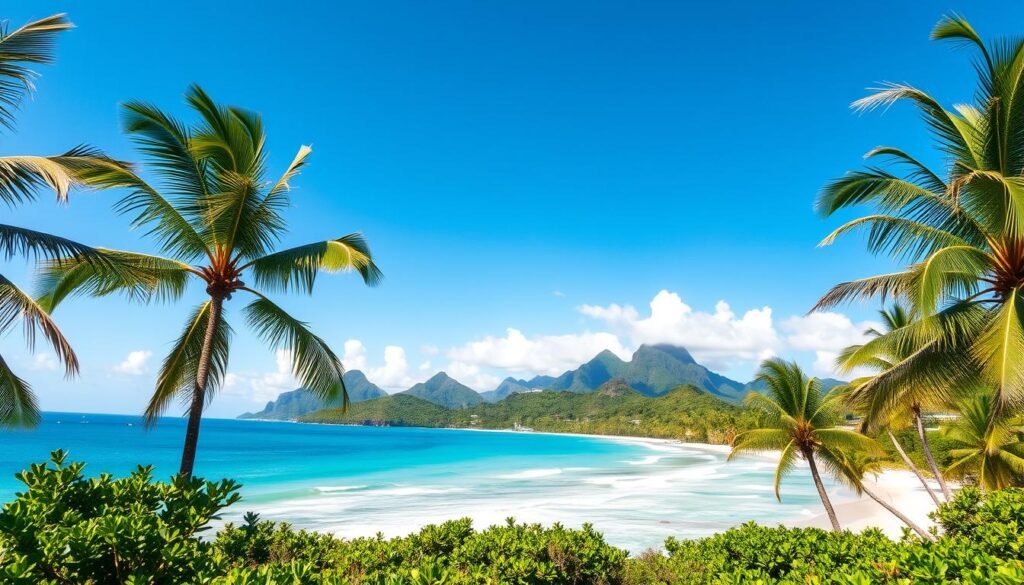
I translate seasonal charts into plain facts about sun, rain, and sea for travelers. Below I give clear figures so you can pack right and plan outdoor days.
Air temps and seasonal swings
Highs trend near 86°F from May through September. Nights are warm then, and humidity rises.
The coolest stretch is January–February, with lows around 71.6°F and noticeable trade-wind breezes that make evenings feel fresher.
Rainfall and brief showers
Rainfall climbs June–November, peaking in September and October. Many showers are short bursts rather than all-day downpours.
“A few wet hours can mean lush trails and quieter beaches the rest of the day.”
Sea conditions and visibility
Water warms to about 82°F around April–May. Visibility for snorkeling is clearest December–April when seas are calm.
- I watch temperatures and humidity so you know when hikes feel sticky.
- Track a few days of detailed climate charts before packing.
- Bring a light long-sleeve for breezier winter nights.
Month-by-month guide to the island’s feel
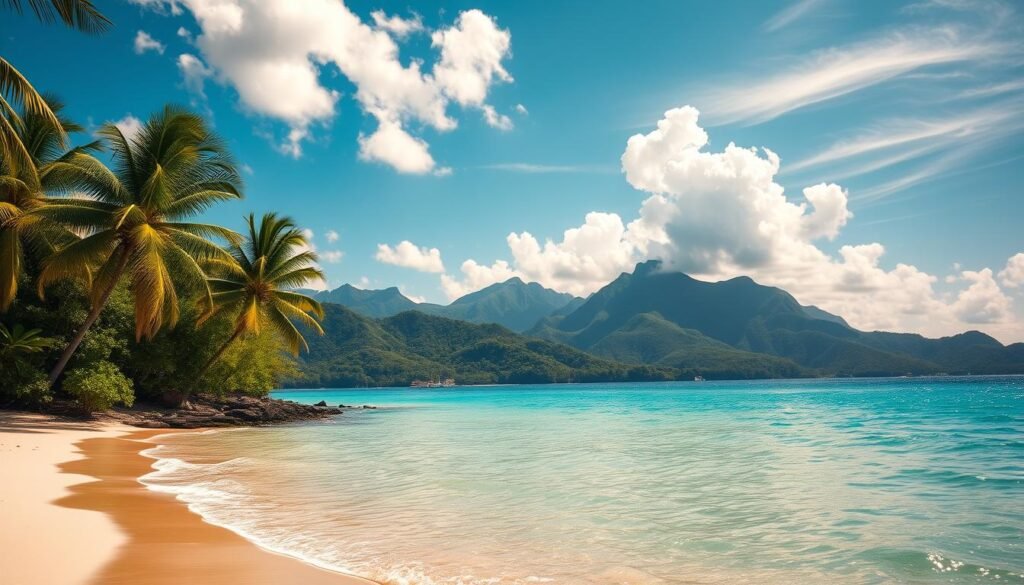
I walk through the months so you can feel how the island shifts from festive buzz to quiet green days. Read this and pick the days that match your plans.
December–February
The peak season brings mild temperatures and steady breezes. Nights are cooler and boat trips are calm.
Whale watching begins this window, and lively evenings make for easy dining and island nights.
March–April
Sunshine stays strong but crowds thin. These months are great for long beach days and clearer snorkeling.
May–June
Temperatures climb and tropical showers start. You can find solid pre-summer deals on rooms.
July–August
These are the hottest days and Carnival brings loud music and colorful parades. The rainforest is at its greenest.
September–October
The island is quiet with the best rates. Brief rain bursts happen, and Creole Heritage Month peaks with Jounen Kwéyòl.
November
November feels like a shoulder rebound. Expect some brief rain but many sunshine windows before the next peak.
“Plan hikes early in hot months, use evenings for breezy dining, and stay flexible around quick showers and events.”
best time to visit st lucia for different travel styles
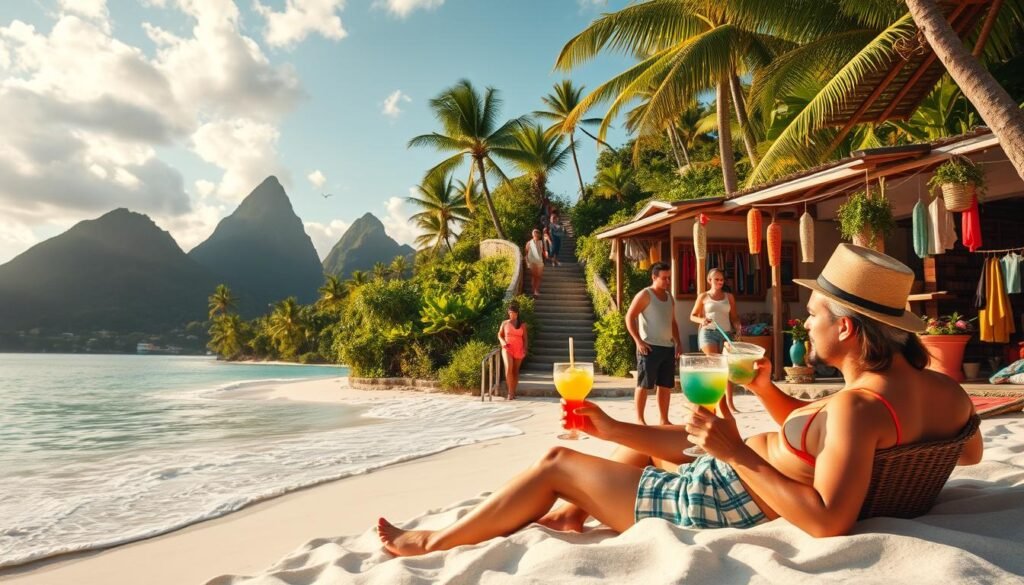
I’ll match different travel styles with the months that highlight their strengths. Below I lay out clear choices so you can plan your trip around what you love most.
Beach and sunshine seekers
For long stretches of sunshine and calm water, pick the dry season (December–April). I recommend this window for easy snorkeling, sailing, and relaxed days on the beach.
Adventure and hiking lovers
If green trails and fuller waterfalls are your draw, aim for May–November. Morning starts keep hikes cool and reward you with vivid rainforest views and great activities inland.
Cultural travelers and festival fans
Festivals run across the year. Jazz in May and Carnival in July are highlights I watch for. Plan around those dates and tuck quieter beach days on either side for balance.
Romance, honeymoons, and destination weddings
Couples often favor November–February for milder evenings, clearer skies, and sunset sails. Choose shoulder months if you want privacy and quieter boutique stays.
Practical tips: Pack light, breathable layers. Start active outings early and schedule watersports late afternoon. For photos, chase golden hours and the clear windows after brief showers for dramatic shots of the Pitons.
“Match your trip length to your wish list: 4–5 days for a reset, 7–10 for deeper island exploration.”
Events and festivals: when the island’s music and culture take center stage
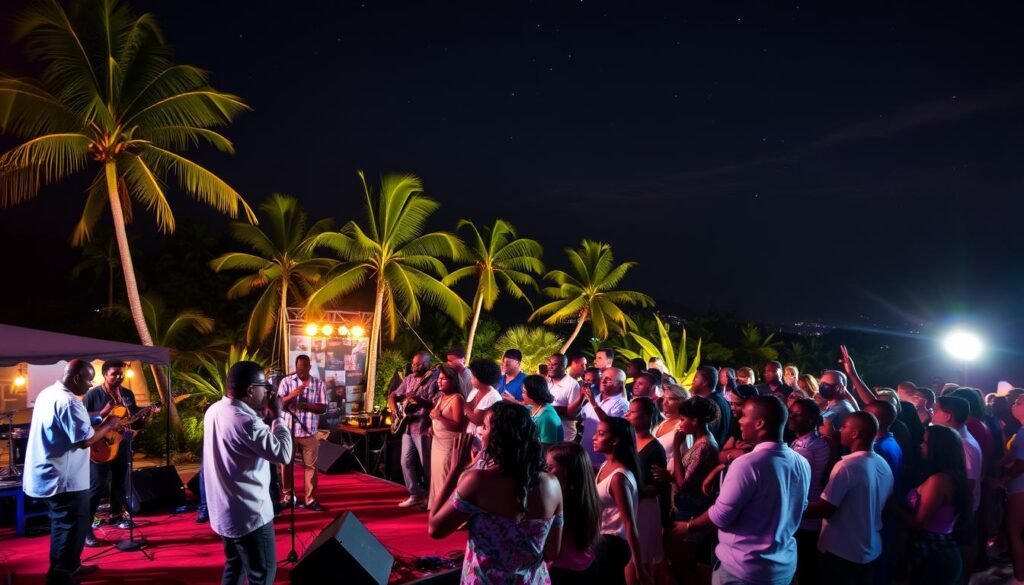
I track the calendar so you can hit the loud nights and still enjoy calm mornings on the beach. Below I map the main draws and what each one feels like on the ground.
Saint Lucia Jazz & Arts Festival — May
The lucia jazz scene gathers at Pigeon Island with big stages, late sets, and local food stalls. This jazz festival mixes international acts with island talent for a music-filled run of days.
Carnival — July
Carnival peaks with parades, costumes, and street parties that spill into nights and early mornings. Expect loud beats, colorful floats, and lots of dancing.
August highlights: Roots & Soul and Chocolate Heritage
Roots & Soul brings soulful acts and DJ sets. Chocolate Heritage Month pairs tasting events with cultural programming for food lovers.
Food & Rum — September
Chef events, rum tastings, and live music create a foodie-driven festival experience.
Creole Heritage Month and Jounen Kwéyòl — October
Heritage month culminates in Jounen Kwéyòl with traditional dress, Creole food, and a full display of culture.
Weekly vibe: Gros Islet Friday Night
Every Friday night the street party serves BBQ, DJs, and dancing year-round. It’s a great low-key way to feel the island’s nightlife any week.
| Month | Main draw | What to expect |
|---|---|---|
| May | Saint Lucia Jazz & Arts Festival | Concert stages at Pigeon Island; evening shows |
| July | Carnival | Parades, costumes, street parties |
| Aug–Sep | Roots & Soul / Chocolate / Food & Rum | Live music, tastings, chef events |
| Oct | Creole Heritage Month | Traditional food, fashion, Jounen Kwéyòl |
“Plan festival nights with a rest day after; pair big evenings with a sunset sail or an easy snorkel.”
Booking tip: stay near venues if you want short walks, or choose a quieter base to recharge between activities. These events give lots of chances to hear music and soak in local culture across the season.
Crowds, prices, and booking windows
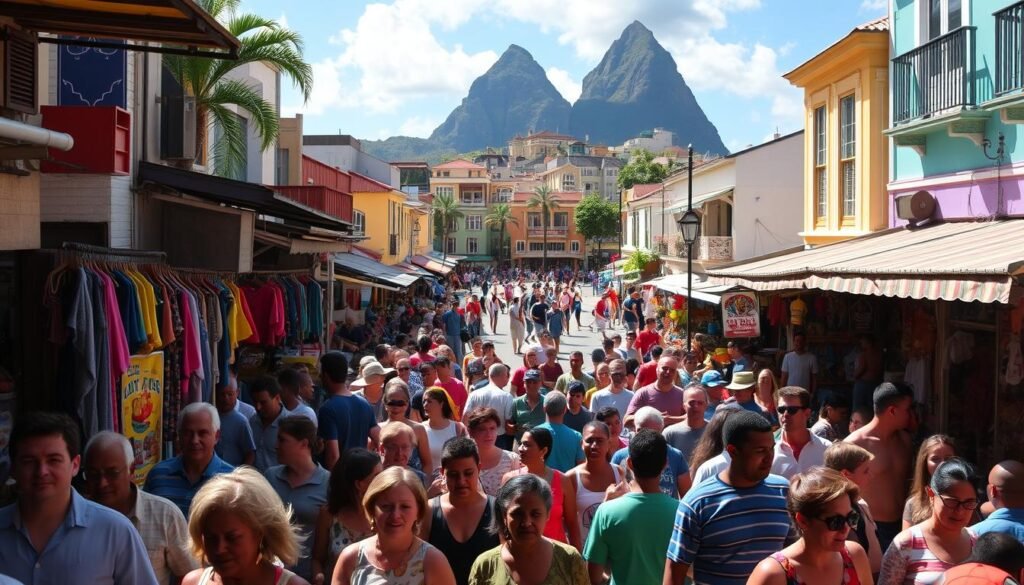
I track demand patterns so you won’t be surprised by sold-out rooms or sky-high fares. This section shows when crowds swell, where value appears, and how I book to lock in ocean views and smooth days on the island.
Peak demand mid-December to mid-April — book 6–12 months ahead
Peak months bring increased visitors and lower availability. I recommend reserving preferred rooms and tours about 6–12 months ahead in this season.
Why book early? Popular hotels fill fast, and waterfront suites vanish first. Advance booking also secures better dining times and shore excursions.
Off-season value May–November — hotel deals and flight savings
From May through November you’ll find the most savings. Airlines and hotels offer lots of promotions, and availability is plentiful.
Off-season travel often means quieter beaches, relaxed service, and better odds for room upgrades.
“Flexible dates and midweek arrivals can cut costs without shaving quality from your trip.”
| Window | Demand | Typical savings | Booking advice |
|---|---|---|---|
| Mid-Dec–Mid-Apr | High crowds | Low — premium rates | Reserve 6–12 months ahead; book tours early |
| May–Sep | Low–Moderate | High — flights and hotels reduced | Watch promos; aim for midweek stays |
| Oct–Nov | Moderate | Moderate — shoulder deals | Book 2–4 months ahead; flexible cancellations |
Practical tips: I use flexible arrival days, loyalty perks, and travel insurance to keep plans flexible. Time deposits and clear cancellation policies protect your reservation if plans change.
Rain, storms, and hurricanes: realistic expectations
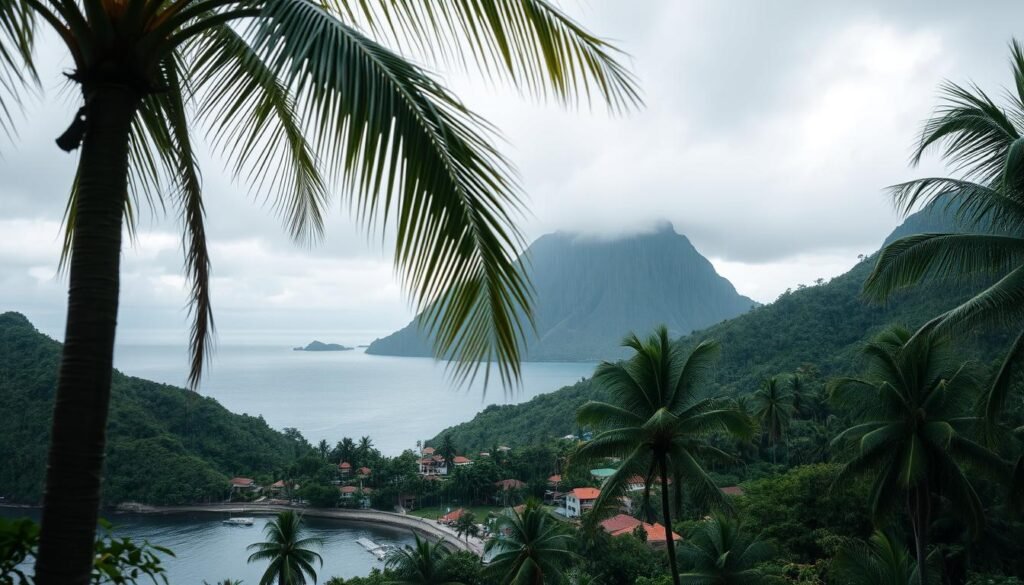
Let me demystify how rain and tropical storms usually play out on the island. I focus on facts so you can plan your days without worry.
Hurricane season runs June 1–November 30, but direct hits are rare in saint lucia. In 170 years there were only 14 hurricanes recorded within about 60 miles. The highest risk months are August and September.
Hurricane risk and historical perspective
Historically the odds remain low, yet I still suggest travel insurance for trips in june november. It offers peace of mind during the core wet season.
Why brief showers rarely ruin a trip
The wet season brings average rainfall of around 7–10 inches per month. Most rain falls as short bursts, and storms tend to hit inland more than the perimeter beaches. I schedule beach time around likely shower windows and keep plans flexible.
- Packing: breathable fabrics and quick-dry layers for humidity and changing temperatures.
- Planning: start hikes early and leave flexible slots so a brief downpour becomes a coffee break.
- Perk: rain refreshes waterfalls and greens, giving great photo backdrops with fewer people.
| Topic | Typical pattern | Practical tip |
|---|---|---|
| Hurricane risk | Low historical odds; peak Aug–Sept | Buy travel insurance for june november |
| Rainfall | 7–10 in/month during wet season | Plan flexible days; expect short showers |
| Storms | Often inland, brief cells | Keep beach mornings; hike early |
“A brief storm can mean lush trails and quieter viewpoints for the rest of the day.”
Sea, sand, and visibility: timing your beach and water activities
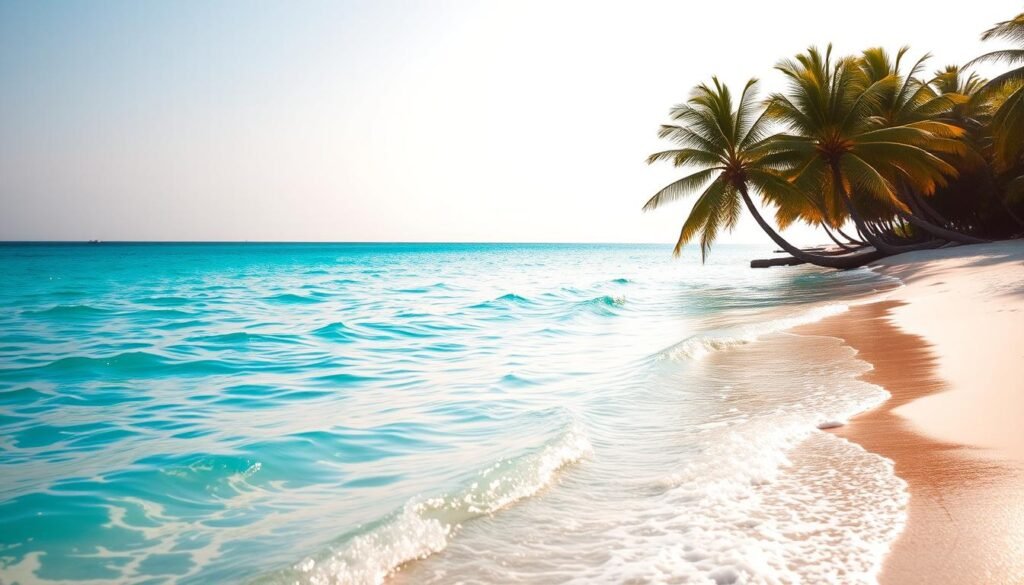
I watch wind, swell, and sun angle so each water day gives the clearest views and the smoothest rides. December–April brings calm seas, long sunshine windows, and the clearest underwater visibility for short swims and long snorkels.
Snorkeling and swimming: calm seas December–April
Why this season works: calmer sea conditions mean brighter visibility and gentler surf at popular snorkel spots. Water warms toward April–May, reaching about 82°F, which makes swims comfortable without heavy suits.
Sailing and sunset cruises: year-round favorites
Sailing and sunset cruises run any month, but the dry season gives smoother rides and clearer horizons. Breezier days are great for coastal cruising, while sheltered coves suit kayaking and SUP when a front moves through.
- I pick mornings for snorkel sessions — sun angle and glassy water boost clarity.
- Pack a light rash guard, reef-safe sunscreen, and a quick-dry towel for comfort.
- My favorite day: an early swim, a shaded mid-day break, then a golden-hour sail for perfect sun and sea balance.
| Activity | Ideal window | Practical tip |
|---|---|---|
| Snorkeling | Dec–Apr | Go early for best visibility |
| Sailing / Cruises | Year-round | Choose dry-season days for smoother rides |
| Kayak / SUP | Calm days | Use sheltered bays if wind picks up |
“Mornings often offer the calmest sea and the brightest underwater clarity.”
Where the day flows differently: timing Castries and iconic sights
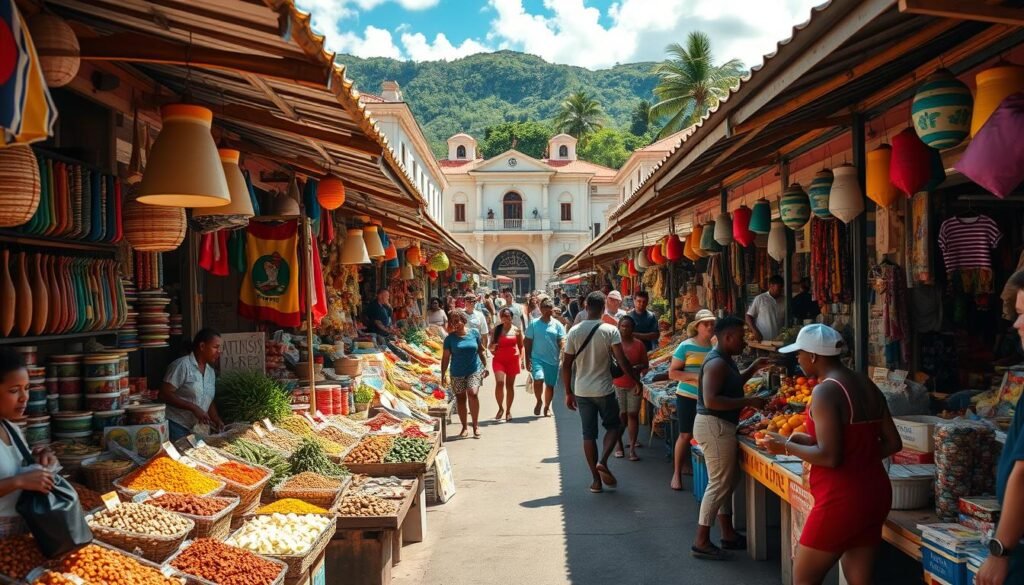
A morning in Castries can feel like a different place than the afternoon rush. I aim for about 10 AM to wander when streets are quieter and stalls are easy to browse.
Castries rhythm: Sunday is the slowest day, when the whole place feels relaxed. I like starting in Castries Market, then moving through Vendor’s Arcade and La Place Carenage for a true local pulse.
Castries timing tips: quieter mornings, easy Sundays
Arrive around 10 AM to avoid traffic and catch vendors before the afternoon rush. Take short breaks in shaded spots and be polite when haggling — a smile goes far.
Seeing the Pitons by land and sea: sunset sails and clear-day views
For the Pitons, I chase clear mornings from land for crisp photos, then book a sunset sail. The silhouette against the warm sun makes the whole island moment feel cinematic.
- Start with a land viewpoint in the morning for clarity.
- Save a sunset cruise for dramatic silhouettes and calm light.
- Sequence markets and overlooks to avoid midday congestion.
“Keep your trip flexible so a scenic overlook or market stall can become a memorable experience.”
My quick picks: the right time of year for your ideal trip
I’ll lay out quick picks so you can match the island’s rhythms with your must-have plans.
Lowest crowds and great weather balance: April or November
I recommend April or November if you want fewer people with good weather balance. These months often deliver sunshine windows and lighter crowds. You’ll find easier booking and calmer beaches without peak prices.
Greenest hikes and waterfalls: May to November
For lush trails and full waterfalls pick May through November. Morning hikes feel cooler and photo opportunities are plenty. If you chase vivid rainforest views, this season rewards effort.
Sun-soaked honeymoon or beach escape: December to April
December through April gives the classic beach-and-sunshine combo and calm seas. Expect steady temperatures and bright days ideal for snorkeling, sailing, and sunset sails.
- Value tip: you’ll often find plenty of savings on flights and hotels outside peak months.
- Booking note: reserve 6–12 months ahead for in-demand rooms and ocean views.
- Packing cue: light layers, reef-safe sunscreen, and early starts for hikes and snorkels.
“Pick the window that fits your trip style: lazy beach days, rainforest walks, or a bit of both.”
Conclusion
, I’ll close by mapping the season perks and next steps.
I recap: the driest and calmest stretch runs December–April for classic beach days. May–November brings green trails, lower rates, and festival culture across several months.
Use this guide to match your goals — sunny swims, rainforest hikes, or lively events — and plan accordingly. Lock dates early and reserve hotels about 6–12 months ahead if you aim for peak windows.
There is plenty of warmth and beauty year-round on the island. For a quick refresher on timing and details, see this best time to visit Saint Lucia. Choose your season, pencil in must-do experiences, and you’ll have reasons to return.


